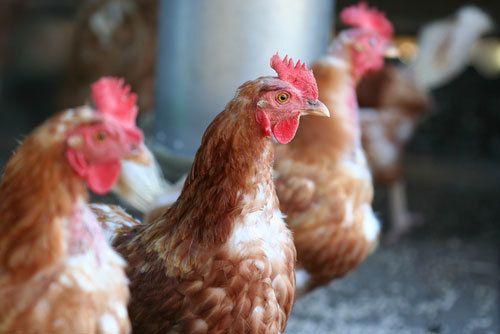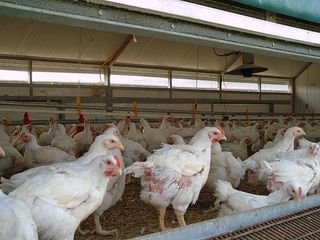
Does 'Cage-Free' Mean a Better Life for Chickens?

This article was originally published at The Conversation. The publication contributed the article to Live Science's Expert Voices: Op-Ed & Insights.
Massachusetts is the latest state to vote on a ballot initiative to increase the amount of space that animals are allowed in industrial food production systems. It prohibits keeping pigs, cows and egg-laying hens in tight confinement that "prevents the animal from lying down, standing up, fully extending its limbs, or turning around freely."
You might think its passage is a major moral victory, at least for chickens, but is it? As a philosophy professor who's worked on food issues for my entire career, I've come to believe that questions of animal welfare are more complicated than they seem at first glance. It's not a clear choice which of the possible living conditions for egg-laying hens — enriched cages, cage-free systems, free-range setups — serve them the best.
What does humanity owe chickens, anyway?
The philosophical question of whether animals deserve any kind of moral consideration has been debated at least since the ancient Greeks.
At one far end of the spectrum are those who say nonhumans cannot be regarded as proper subjects of moral concern. Some hold this on the basis of divine revelation — the other animals were put here for humankind to use as they see fit — while others deny that animals have the kind of subjectivity or experience that could give rise to a moral duty or obligation on our part. The 16th-century philosopher Rene Descartes likened animals to machines.
All the way at the other end of the spectrum are those who argue that what we owe to animals is not unlike what we owe to each other. We should not kill them, nor should we cause them pain or suffering save under highly unusual circumstances. We certainly should not eat them.
Eggs occupy a theoretically ambiguous place on this spectrum, as it is possible to produce them without killing any chickens. Nevertheless modern egg production does involve killing chickens. First, virtually all male chicks are destroyed within a few moments of hatching (though the egg industry has pledged to end this practice by 2020, using technology to determine the sex of fertilized eggs rather than waiting for chicks to hatch).
Sign up for the Live Science daily newsletter now
Get the world’s most fascinating discoveries delivered straight to your inbox.
And egg producers will not bear the expense of continuing to feed hens after they have gotten too old to lay eggs. When the rate of lay declines, henhouses are "depopulated," meaning birds are removed, killed and their carcasses are composted. As such, those who occupy the ethical vegetarian end of the animal ethics spectrum are no more supportive of the egg industry than they are of beef or pork production.

What's best for the hens?
Egg production has been a key target of animal welfare initiatives because at one time layers were so crowded that they literally had to stand on top of one another in the wire cages used by the modern egg industry. We can't be sure these stocking densities have been entirely eliminated, but the vast majority of table eggs today come from chickens that have at least enough space to stand on the floor of their cage.
More important than these increased space allotments is the introduction of amenities that clearly matter to chickens: nest boxes, scratch pads and perches. These enhancements allow the birds to engage in the perching, dust-bathing, nesting and foraging behaviors they are highly motivated to perform.
By 2010, a consensus emerged among producers and some activists for moving to much larger cages that provided opportunities for most of chickens' natural behaviors — the so-called enriched or colony cage. From the producer perspective, enriched cages represented the best compromise between slightly higher costs and improved welfare for hens. But recent pledges to source eggs from cage-free facilities have virtually taken the opportunity for enriched cages off the table. And that is where the moral uncertainty begins to turn wicked.
Out of the cage, into the fire
Cage-free and free-range systems clearly do a better job of allowing hens to express behaviors that are similar to those of wild jungle fowl. They can move around, and they have better opportunities for scratching, dust bathing and foraging. However, in comparison to enriched cages, hens in cage-free and free-range facilities suffer injuries simply because they move around more. Access to the outdoors often means that predators also have access to hens, and some are inevitably taken by hawks, foxes or the like.
A curious ethical point is that people seem to be roughly split on whether being chased and eaten by a hawk or a dog is a bad thing from a chicken's perspective. In research done at Oklahoma State University, 40 percent of respondents saw the suffering of animals as the root issue for ethics, while 46 percent judged that pain, suffering or discomfort would not be significant if it was consonant with what an animal would experience in nature. Getting eaten by predators is certainly what chickens and their close relatives experience in the wild. (The remaining 14 percent of people surveyed didn't care much about animal welfare beyond being sure that animals' basic needs are met.)
Further complicating the "freedom" of cage-free and free-range enclosures, hens will peck one another in an effort to establish a dominance order. In small groups (the 40 to 60 birds that would be found in the enriched-cage system), this behavior generally recedes. But in flocks of 100,000 or more chickens, the least dominant birds can be subjected to so much pecking from other hens that their welfare is clearly worse than it would be in an enriched cage. Welfare scientists tend to favor aviaries (cage-free) over floor systems (free-range) because they allow better perching and thus give less dominant birds better places to hide.
Egg producers limit the damage that birds can do to each other by trimming off the sharp tip of their beak (which is also controversial). Even still, higher mortality from pecking gets treated as a cost of business in cage-free production facilities.
It is possible to house chickens in groups of 40 to 60 birds where pecking orders become stable quickly, but the roughly 6' by 12' enclosures for these groups look suspiciously like a cage to most people. This option may no longer be an option, however. Not only do ballot initiatives like the one in Massachusetts pass with overwhelming support, grocery stores and many chain restaurants are now pledging to abandon suppliers who utilize cages over the next five to 10 years.

With the best of intentions
Egg production seems to be especially susceptible to actions where the public is highly confident that they're in the right — even while many who've look closely at the alternatives are far less sure about how it feels to be a chicken in these operations.
Massachusetts voters thought chickens — as well as the pigs and cows that become pork and veal — would be better off in less tight quarters. Since the ban applies to the sale of any products from animals raised in restrictive cages, the ballot measure could have repercussions for food suppliers based far beyond Massachusetts. Opponents of the initiative predict the price of a dozen eggs will spike.
So do chickens benefit from more space, and should we turn them out of their cages? If we are trying to help them live a more natural kind of existence, then maybe we should. If we are interested in limiting the injuries they suffer from being pecked by other birds, as well as from getting hunted and killed by hawks, dogs and other predators, maybe not.
Paul B. Thompson, Professor & W K Kellogg Chair in Agricultural, Food and Community Ethics, Michigan State University
This article was originally published on The Conversation. Read the original article. Follow all of the Expert Voices issues and debates — and become part of the discussion — on Facebook, Twitter and Google +. The views expressed are those of the author and do not necessarily reflect the views of the publisher. This version of the article was originally published on Live Science.












